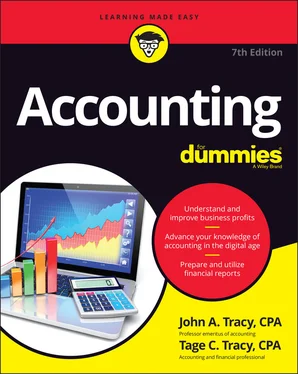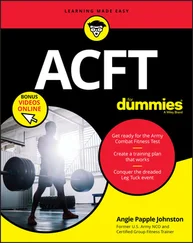John A. Tracy - Accounting For Dummies
Здесь есть возможность читать онлайн «John A. Tracy - Accounting For Dummies» — ознакомительный отрывок электронной книги совершенно бесплатно, а после прочтения отрывка купить полную версию. В некоторых случаях можно слушать аудио, скачать через торрент в формате fb2 и присутствует краткое содержание. Жанр: unrecognised, на английском языке. Описание произведения, (предисловие) а так же отзывы посетителей доступны на портале библиотеки ЛибКат.
- Название:Accounting For Dummies
- Автор:
- Жанр:
- Год:неизвестен
- ISBN:нет данных
- Рейтинг книги:3 / 5. Голосов: 1
-
Избранное:Добавить в избранное
- Отзывы:
-
Ваша оценка:
- 60
- 1
- 2
- 3
- 4
- 5
Accounting For Dummies: краткое содержание, описание и аннотация
Предлагаем к чтению аннотацию, описание, краткое содержание или предисловие (зависит от того, что написал сам автор книги «Accounting For Dummies»). Если вы не нашли необходимую информацию о книге — напишите в комментариях, мы постараемся отыскать её.
Accounting For Dummies
Accounting For Dummies — читать онлайн ознакомительный отрывок
Ниже представлен текст книги, разбитый по страницам. Система сохранения места последней прочитанной страницы, позволяет с удобством читать онлайн бесплатно книгу «Accounting For Dummies», без необходимости каждый раз заново искать на чём Вы остановились. Поставьте закладку, и сможете в любой момент перейти на страницу, на которой закончили чтение.
Интервал:
Закладка:
 To produce accurate financial information, every business must develop, implement, maintain, and manage a properly functioning accounting system that at its foundation relies on establishing, implementing, and adhering to agreed-upon accounting policies, procedures, and controls applied on a consistent basis and in accordance with generally accepted accounting principles (GAAP).
To produce accurate financial information, every business must develop, implement, maintain, and manage a properly functioning accounting system that at its foundation relies on establishing, implementing, and adhering to agreed-upon accounting policies, procedures, and controls applied on a consistent basis and in accordance with generally accepted accounting principles (GAAP).
These generally accepted accounting principles are “a set of rules that encompass the details, complexities, and legalities of business and corporate accounting.” These rules are established by various accounting organizations, boards, and groups, with the primary group being the Financial Accounting Standards Board (FASB), which uses GAAP as the foundation for its comprehensive set of approved accounting methods and practices.
There you have it — when producing financial information, businesses should adhere to GAAP as established by FASB. Seems simple enough, but as you work through the remainder of this book, it should become abundantly clear that GAAP is more or less a series of guidelines that businesses can use to provide a certain amount of leeway when actual financial information is produced. Or maybe the best way to think of it is referring to this quote from Captain Barbossa from the Pirates of the Caribbean franchise: “And thirdly, the code (translation to accounting — GAAP) is more what you’d call guidelines than actual rules. ” Yes, very good guidelines but guidelines nonetheless that provide accountants with a reasonable amount of leeway when preparing financial information.
Chapter 2
Introducing Financial Statements
IN THIS CHAPTER
 Identifying the information components in financial statements
Identifying the information components in financial statements
 Evaluating profit performance and financial condition
Evaluating profit performance and financial condition
 Knowing the limits of financial statements
Knowing the limits of financial statements
 Recognizing the sources of accounting standards
Recognizing the sources of accounting standards
Chapter 1presents a brief introduction to the three primary business financial statements: the income statement, the balance sheet, and the statement of cash flows. In this chapter, you get more tidbits about these three financials, as they’re sometimes called. Then, in Part 2, you really get the goods. Remember when you were learning to ride a bicycle? Chapter 1is like getting on the bike and learning to keep your balance. In this chapter, you put on your training wheels and start riding. Then, when you’re ready, the chapters in Part 2explain all 21 gears of the financial statements bicycle, and then some.
For each financial statement, we introduce its basic information components. The purpose of financial statements is to communicate information that is useful to the readers of the financial statements, to those who are entitled to the information. Financial statement readers include the managers of the business and its lenders and investors. These constitute the primary audience for financial statements. (Beyond this primary audience, others are also interested in a business’s financial statements, such as its labor union or someone considering buying the business.) Think of yourself as a shareholder in a business. What sort of information would you want to know about the business? The answer to this question should be the touchstone for the accountant in preparing the financial statements.
The financial statements explained in this chapter are for businesses. Business financial statements serve as a useful template for not-for-profit (NFP) entities and other organizations (social clubs, homeowners’ associations, retirement communities, and so on). In short, business financial statements are a good reference point for the financial statements of non-business entities. There are differences but not as many as you may think. As we go along in this and the following chapters, we point out the differences between business and non-business financial statements.
Toward the end of this chapter, we briefly discuss accounting standards and financial reporting standards. Notice here that we distinguish accounting from financial reporting:
Accounting standards deal primarily with how to record transactions for measuring profit and for putting values on assets, liabilities, and owners’ equity.
Financial reporting standards focus on additional aspects such as the structure and presentation of financial statements, disclosure in the financial statements and elsewhere in the report, and other matters.
We use the term financial accounting to include both types of standards.
 The philosophy behind the need for standards is that all businesses should follow uniform methods for measuring and reporting profit performance and reporting financial condition. Consistency in financial accounting across all businesses is the name of the game. We won’t bore you with a lengthy historical discourse on the development of accounting and financial reporting standards in the United States. The general consensus (backed by law) is that businesses should use consistent accounting methods and terminology. General Motors and Microsoft should use the same accounting methods; so should Wells Fargo and Apple. Of course, businesses in different industries have different types of transactions, but the same types of transactions should be accounted for in the same way. That is the goal.
The philosophy behind the need for standards is that all businesses should follow uniform methods for measuring and reporting profit performance and reporting financial condition. Consistency in financial accounting across all businesses is the name of the game. We won’t bore you with a lengthy historical discourse on the development of accounting and financial reporting standards in the United States. The general consensus (backed by law) is that businesses should use consistent accounting methods and terminology. General Motors and Microsoft should use the same accounting methods; so should Wells Fargo and Apple. Of course, businesses in different industries have different types of transactions, but the same types of transactions should be accounted for in the same way. That is the goal.
Setting the Stage for Financial Statements
This chapter focuses on the basic information components of each financial statement reported by a business. The first step is to get a good idea of the information content reported in financial statements. The second step is to become familiar with more details about the “architecture,” rules of classification, and other features of financial statements (see Part 2).
Offering a few preliminary comments about financial statements
Realistic examples are needed to illustrate and explain financial statements. But this presents a slight problem. The information content of a business’s financial statements depends on whether it sells products, services, or both (for instance, Apple sells both products and services); invests in other businesses; and so on. For example, the financial statements of a movie theater chain are different from those of a bank, which are different from those of an airline, which are different from an automobile manufacturer’s, which are different from — well, you name it.
The classic example used to illustrate financial statements involves a business that sells both products and services, and sells on credit to its customers. Therefore, the assets in the example include receivables from the business’s sales on credit and inventory of products it has purchased or manufactured that are awaiting future sale. Keep in mind, however, that many businesses that sell products do not sell on credit to their customers. Many retail businesses sell only for cash (or accept credit or debit cards that are near cash). Such businesses do not have a receivables asset.
Читать дальшеИнтервал:
Закладка:
Похожие книги на «Accounting For Dummies»
Представляем Вашему вниманию похожие книги на «Accounting For Dummies» списком для выбора. Мы отобрали схожую по названию и смыслу литературу в надежде предоставить читателям больше вариантов отыскать новые, интересные, ещё непрочитанные произведения.
Обсуждение, отзывы о книге «Accounting For Dummies» и просто собственные мнения читателей. Оставьте ваши комментарии, напишите, что Вы думаете о произведении, его смысле или главных героях. Укажите что конкретно понравилось, а что нет, и почему Вы так считаете.












